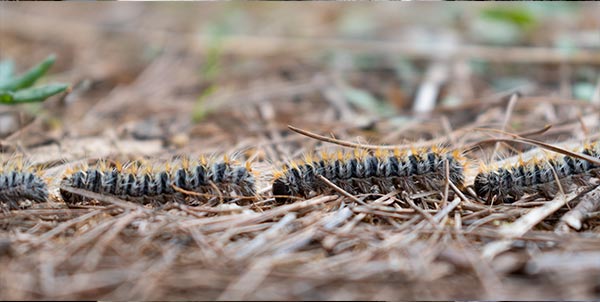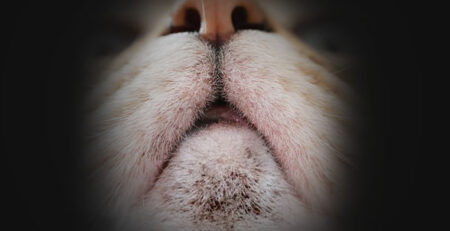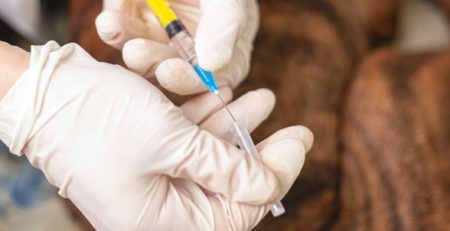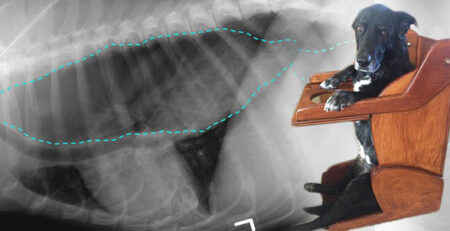Table of Contents
THE PROCESSIONARY MOTH, THAT FUNNY, HAIRY CATERPILLAR THAT DESCENDS FROM PINES AND OAKS, IS ANYTHING BUT HARMLESS. WE EXPLAIN HOW TO RECOGNIZE IT TO AVOID IT AND TO PRESERVE YOUR DOG FROM OFTEN LETHAL CONTACT CONSEQUENCES.
Dogs, cats and even horses, sniffing the ground or grazing the grass, risk contact during this period, with sometimes fatal consequences, with some only seemingly harmless caterpillars that are, in fact, ruthless killers: we refer to the larvae of the processionary moth, whose stinging properties are well known to those who have carelessly touched them or handled their nests.
In the unfortunate event that your dog has a close encounter with the processionary moth caterpillar, prompt action is required.
HAVE YOU EVER WONDERED WHAT THE PROCESSIONARY MOTH IS AND WHY IT OCCURS AT THIS TIME?
The processionary moth is a highly destructive insect to the foliage of pines and oaks, trees on which it normally nests, and which, in its larval stage, appears as a caterpillar covered in thick urticating hair.
The processionary moth larvae, having reached maturity in early March, leave their nests and descend the logs to the ground in a line, marching as if in “procession” (hence the name processionary moth) in search of an ideal place to bury themselves to weave their cocoon and transform from chrysalis to moth. This process lasts at least until the end of April.
The nocturnal “triangular butterflies” we admire during the summer are nothing more than adult processionary moths.
DO YOU KNOW HOW TO RECOGNIZE PROCESSIONARY MOTH NESTS?
Processionary moth nests, where larvae overwinter, are recognizable even from a distance: they are pyriform in shape and bright white in color.
Prudence dictates that processionary moth caterpillars should never be touched or their nests opened.
They can be “spotted” positioned on the tops and at the apexes of pine and oak branches.
If you spot them, immediately move away from infested areas.
And if you stay preemptively away from pine and oak forests during walks with your dog, that’s even better.
DO YOU KNOW WHY PROCESSIONARY MOTH CATERPILLARS ARE SO DANGEROUS?
The danger lies in the stinging hairs that cover the body of the processionary moth.
The hairs are soaked in formic acid a strongly caustic substance that caterpillars secrete from their glands to defend themselves against their natural predators.
And in addition, the hooked shape of the processionary moth’s hairs allows it to “latch on” to the victim, causing reactions to the skin, mucous membranes, eyes and respiratory tract.
DO YOU KNOW HOW DEVASTATING CONTACT WITH THE PROCESSIONARY MOTH CAN BE FOR YOUR DOG?
Symptoms from contact, or worse, ingestion, in dogs are immediate and obvious:
-a sudden and intense salivation caused by the inflammatory process in the mouth, esophagus and stomach
-The tongue may swell to such an extent that it may even cause the animal’s death by suffocation
In other cases, stinging hairs, due to the process of destruction of the cellular tissue of the tongue itself, can cause total or partial necrosis of the affected areas.
Other relevant symptoms are fever, refusal of food, vomiting, and even hemorrhagic diarrhea.
IMMEDIATE INTERVENTION CAN SAVE YOUR DOG’S LIFE
A first aid operation that can prove very useful is to remove residual hair from the oral cavity.
This is done by copious washing of the animal’s mouth with water, taking care to wear latex gloves to avoid in turn touching the stinging hairs.
It is critically important to take the animal to your trusted veterinarian as soon as possible.
Timely action can save your dog’s life!
WHAT ARE THE EFFECTS OF CONTACT WITH THE PROCESSIONARY MOTH ON HUMANS?
The damage caused by contact with processionary moth hairs can also be very serious for humans.
In case of skin contact, painful rashes occur, which can then spread all over the body due to the shedding of hair facilitated by sweat and rubbing of clothing.
In case of contact with the eyes, the immediate consequence is the onset of painful conjunctivitis.
Even worse in case of inhalation or ingestion, the hairs irritate the respiratory tract and inflame the mucous membranes.
DO YOU WANT TO KNOW HOW TO DEFEND YOURSELF FROM THE INVASION OF THE PROCESSIONARY MOTH?
Pest control of processionary moth caterpillars has been mandatory in Italy since 2008, when it was determined that their presence posed a serious threat to human and animal health and the survival of various tree species.
There are several remedies to eradicate the very dangerous caterpillars:
- Pesticides, directly spraying the larvae
- Entomological glue, to be applied to logs
- Biological insecticides namely the bacterium Bacillus Thuringiensis Kurstaki that paralyzes larvae by damaging their nerve centers
- Pheromone traps that attract males thus preventing them from encountering females and consequently fertilizing and reproducing.
Be wary of do-it-yourself methods and do not resort to the use of folk tradition substances, which are dangerous both in handling and ‘use, especially in the presence of children and animals, as well as harmful to the environment.
Such interventions must, of course, be practiced by pest control professionals.
In case of need and urgency, do not hesitate to contact us: the La Veterinaria Clinic is open every day, including holidays, and with First Aid service from 8 pm to 8 am.
For the joy of seeing them happy.











